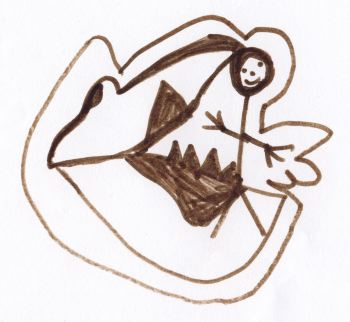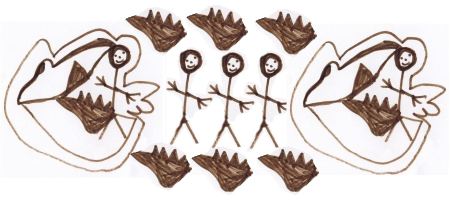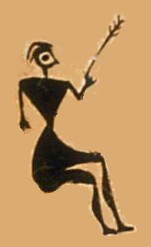
Painting From Life vs. From Photos

Detail from funeral pyre scene on an Attic Geometric krater, second half of 8th century BC

Man being eaten by a crocodile, first half of 21st century AD
The ceramic painting above I borrowed from Victor Bryant’s excellent ceramics website. The drawing on paper is by Fran, who is almost five years old.
The images are similar in that they both depict narrative scenes, and both make use of simple geometric shapes. The vase painting probably represents top quality artwork of its era, making use of a consistent representational system which covers this large vase and many others (presumably painted by many different adults working over many years). The children’s drawing is a one-of-a-kind sketch.
At first glance, the vase painting seems like children’s art made by adults. A key factor that distinguishes the adult work is the consistent repetition of patterns — across the detail, across the vase and across the historical period. There is a discipline here that is alien to the work of a child drawing as play. This use of repetition has substantial advantages. It imparts rhythm and complexity to the work that is lacking in Fran’s image. Repetition creates a decorative effect that masks to some degree the simplicity of the representation. For the sake of comparison, we can apply repetition to Fran’s image:

We can also isolate a figure from the vase painting. With these simple digital manipulation we have not transformed Fran into an Attic geometric vase painter, or turned the vase painter into a child. We have, I think, narrowed the gap.

What I think is interesting here is that what presumably passed for fine work in the 8th century BC probably could be made by children, if they were compelled to work within a disciplined productive system (as the adults were).
Discipline and rigid compliance to style are factors that are quite contrary to our modern notions of art, however. Is the ancient vase painting art, or is it nothing more than systematized children’s decoration?

Pure repetition becomes decorative, as you say. But repetition with intentional variation can be used to convey something; it’s a mechanism or technique like the juxtaposition that Leslie works with in the Hello Kitty series. Maybe it’s what the viewer takes as the message of an artwork that makes it at least seem adult or not.
Steve,
What this post and your comment got me thinking is, what if we give kids interesting elements to use in repetition? I see the vase painting as a sort of art Lego. What could kids build with these pieces?
Karl.
I think your question (“Is the ancient vase painting art…”) is absurd and that the two experiences, represented by the vase painting and Fran’s beautiful drawing, are most meaningful when considered from their own intent.
D.,
If the question is absurd is of little moment, if the answer is interesting.
I agree there is something a bit weird about relating the two images. I felt that I learned something in the process. Perhaps this will be expressed better later.
Karl,
I’ve never seen anything like these figures before. I love the skinny waist, knees, and ankles. This enables Matisse-like curves in the legs, which contrast with the straight lines of the triangular torso. Can you tell us more about this art? For example, what did previous depictions of people look like in this culture (or its predecessor)?
Karl.
I just wonder if your answer has any foundation.
Why? Because I think the premise of the Vase as decorative and Fran’s drawing (Children’s Art) as simple and undisciplined is too reductive. Certainly the repetitive design in the vase can be viewed as a Surface but rooted below are the narratives, the spiritual matters, the social bondings, etc. And though I greatly admire Fran’s imaginative drawing, I am also impressed with work by kids that is more elaborate, nearly obsessive and always disciplined.
D,
If I understand you correctly, you are saying that the narratives etc. are more important than formal aspects (e.g. repetition or not) in differentiating Fran’s work and the vase, or children’s and adult artwork in general. Is that accurate? It fits with what I was trying to say in my first comment. But if content matters more than form in this judgment, are there nonetheless formal elements that seem more characteristic of adults? For example, I’m sure kids care about color, but do they invest much effort in fine nuances of color?
Karl, your question seems to imply you’ve taken the position that children’s decoration is not art.
Maybe Karl, you have described two ends of the spectrum — one end being the spontaneous creation of a visual by a child and the other the intentional creation and recreation of the same visual forms over and over again. Neither is necessarily “art” although in my book,”discipline and rigid compliance to style” are likely to come closer to fitting the category. I thought you might be twitting us a bit with the question.
D. Do you mean that “intent” is the primary element in whether something is art or not? IF that were the case, probably the context of the vase would tell us that the maker didn’t intend it to be “art” while Fran may have been intending her work to be artistic. Or maybe, she just wanted to tell us a story.
If pressed, I suppose I would say that to be labeled art, our consideration has to include the artifact, the artist, the world out of which it was made and in which it currently resides, and the viewer. All have to be considered, and ultimately, the category is unstable, sometimes focusing on intent, sometimes on the artist, sometimes on the definition given by the world.
I think I’m more confused than ever by this topic, which I’m not sure I really understood to being with. But I’m glad I’m not meeting that crocodile.
June, Steve and D,
This post is more a reflection of ongoing thought than polished analysis, as you have each stated in different ways. I am very excited about some of the ideas that the post made me think about, as well as the ideas expressed in your comments. I apologize for the incomplete nature of the presentation. For my part, it has been worth it, even though the results are not yet clear. I appreciate your input and patience. This post could be thought of as a work in progress, like an underpainting, something we have seen with artwork but not so explicitly with blog writing. I appreciate your critique.
S.
“Accurate?” Yes. I mostly appreciate formal qualities as a means for getting me somewhere.
J.
“Intent?” Intent is really important to me, though I certainly do not use it as a parameter for defining what is Art. As you point out, there are many considerations.
K.
Are you familiar with the work of Bill Traylor? I came across his work at a time when I was teaching art to children. His work made me think a lot about shared experiences and the potential for meaning from the simple observations of life.
Also, there is an interesting film coming out, “My Kid Could Paint That.” The NYTimes did an interesting piece on it last week.
http://festival.sundance.org/filmguide/popup.aspx?film=4654
D,
I heard about this film (on Ed’s blog of course). Thanks for the link. I don’t know about the kid in the film, but I will vouch for the authenticity of Fran’s picture. It is 100% child made (but preserved by parents). Here is a comment I left on Ed’s blog regarding children artists competing with adults:
K.
Concerning the child-parent relation and art. While teaching a Portrait class, I overheard this exchange between a hovering parent and her child.
Parent: Is that an ear?
Child: Uh-huh.
Parent: Is that what an ear looks like to you?
Child: Uh-huh.
Parent: Really?
Child: Mom! It’s a horn-ear.
Got a picture?
Looking at the two pictures and considering the question is fascinating. I don’t think children have anything more in mind than recording and analysing the world around them. (think of the art works of children in war zones…) I think this is exactly whatwas in the mind of the decorator of the vase. So does Decoration become Art with the passage of enough time, and the quirky string of (good luck) situations that bring its survival to the modern day? Ergo, can anything modern/contemporary then, be termed ‘Art’?